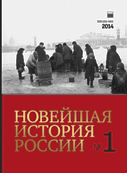От А. В. Колчака — в Красную Армию: служебная занятость и дальнейшие судьбы выпускников младшего класса 4-й очереди ускоренных курсов «белой» Академ
From Kolchak to the Red Army: The Career and Eventual Fate of the Graduates of the Junior Class of the “White” General Staff Academy’s 4th Round of Ac
Author(s): Valery Vladimirovich Kaminsky Subject(s): History
Published by: Издательство Исторического факультета СПбГУ
Keywords: the forth turn of academic accelerated courses; “genshabists”; junior class; Kolchak; Work-Peasant Red Army (WPRA)
Summary/Abstract: On October 30, 1916, the last Russian Tsar Nicolas II ordered the opening of the first, second and the third rounds of accelerated academic courses within the framework of the Nicholaevan General Staff Academy (which had been closed in September 1914 due to the beginning of the First World War). The main objective of these courses was the preparation of headquarters’ specialists to replace the officers were killed during military actions 1915–1916. From November 1916 to the fall of 1918, several hundred Russian officers acquired a basic military-academic education in such courses. By the beginning of 1919, a fourth round of accelerated courses for the junior class was opened in “White” Tomsk. The present article focuses on the “fates” of 51 graduates of the junior class of the above-named courses. This number represents a third of the all the officers trained in this class. A table summarizes the professional biographies of the 51 graduates in three different armed forces: the Russian Imperial Army (RIA), the “White” Army of Admiral A. V. Kolchak and the Workers’ and Peasants’ Red Army (WPRA). The author limits himself to identifying only the military ranks and service` occupations (if known) within the RIA and Kolchak army. This table allows for many other major issues to be cleared up: 1) what were the circumstances under which students of the fourth round of junior academic courses shifted from the Army of Kolchak into the Red Army; 2) how many people were arrested by Cheka at the beginning of the 1920s and whether these arrests affect their future careers in the Red Army; 3) what was distinctive about the Red Army careers of these 51 junior general staff officers; 4) and what was the eventual fate of these people during the 1930s (including their possible repression during the Great Terror).
Journal: Новейшая история России
- Issue Year: 4/2014
- Issue No: 09
- Page Range: 40-68
- Page Count: 29
- Language: Russian

